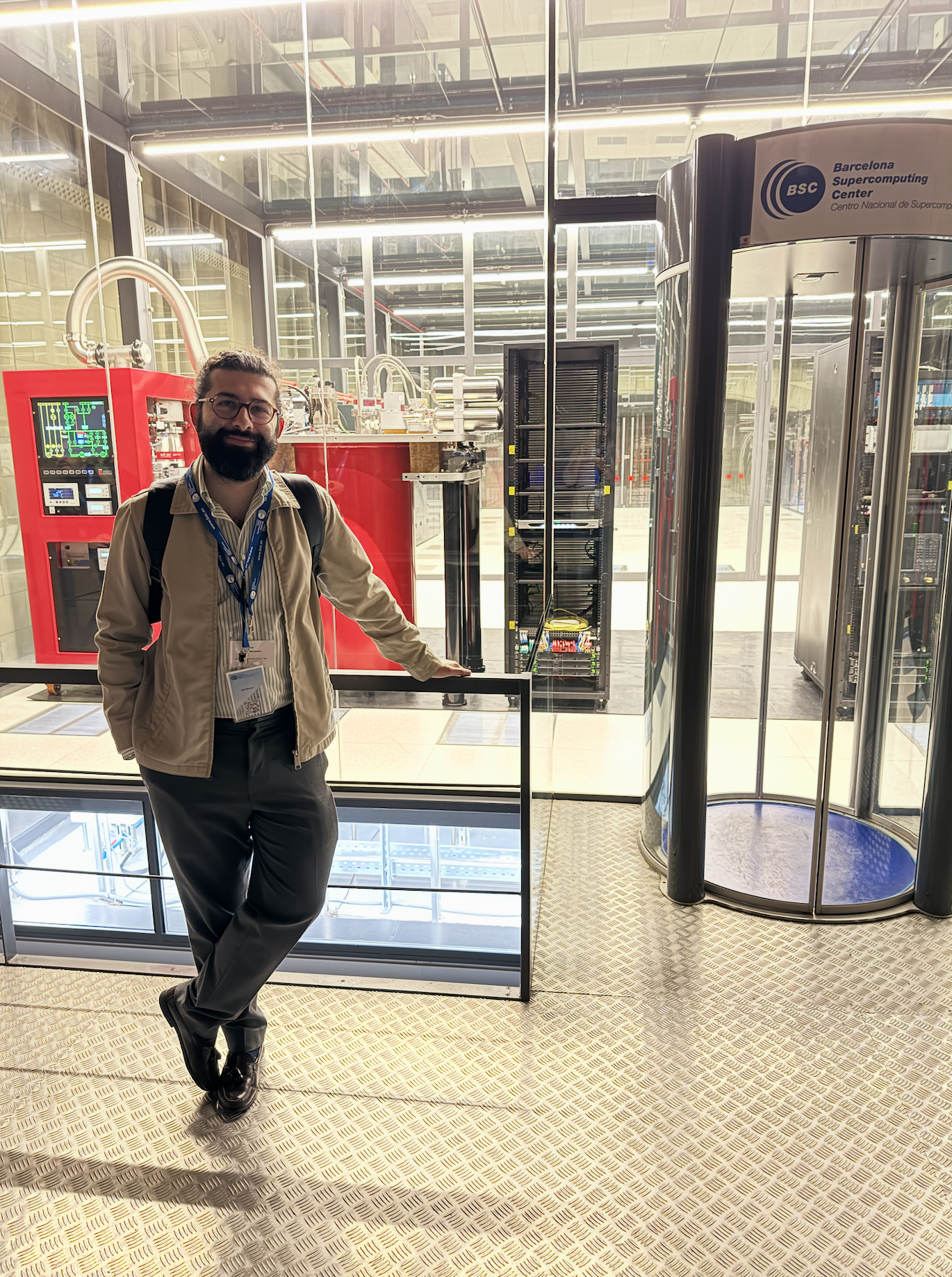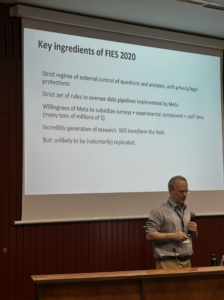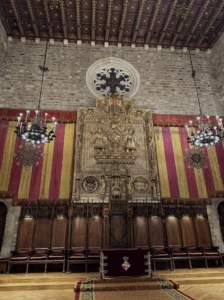Summer Institute in Computational Social Sciences Barcelona

Unai Gómez-Hernández is a Joint PhD at the University of Edinburgh and KU Leuven. His research interests revolve around EU-China relations at the European Parliament, radical right populist parties, and geoeconomics. He has taught several courses at the University of Edinburgh and he currently co-convenes the Europa Postgraduate Research Group (EPRG) at the Europa Institute (Edinburgh). Prior to joining academia, he worked for the regional representation of the Basque Country to the EU and the Basque Environmental Cluster. He holds a bachelor’s degree in Political Science (University of the Basque Country), International Relations (LSE), and a master’s degree in International Relations and Diplomacy of the EU (College of Europe). Here Unai tells us about the training he took after successfully applying for a CDCS Training Bursary.
Last year I had the chance to attend the Summer Institute for Computational Social Sciences in Barcelona, organised by the University of Barcelona. Despite its name, the Summer Institute, or SICSS, took place at the end of October and was dedicated to exploring how to analyse political polarisation.
While in Barcelona, I discovered that the SICSS project was founded by Christopher Bail at Princeton University in 2017 and has since been implemented in more than 50 universities around the world. These SICSS focus on a very small number of participants, around 15-20, and mix traditional social scientists like myself with data scientists to get them to work together on collaborative projects, while receiving in-depth training in computational methods.
 The first days of SICSS were a crash course in Computational Social Science (CSS) and political polarisation. After introducing us to these concepts, the organiser, Professor Camilo Cristancho, presented Andreu Casas and Chico Camargo, who gave keynote presentations on the Moderation of Political Content on Youtube during the 2024 US election and on Network Science, respectively. After these applied demonstrations of CSS, we moved on to learn about the most accessible digital sources of political data and natural language processing (NLP).
The first days of SICSS were a crash course in Computational Social Science (CSS) and political polarisation. After introducing us to these concepts, the organiser, Professor Camilo Cristancho, presented Andreu Casas and Chico Camargo, who gave keynote presentations on the Moderation of Political Content on Youtube during the 2024 US election and on Network Science, respectively. After these applied demonstrations of CSS, we moved on to learn about the most accessible digital sources of political data and natural language processing (NLP).
Once we had received all the training a bunch of PhDs and postdocs could get in three days, we spent some time in research speed dating. The result of this dating process was the groups that would work towards the creation of a pilot study in CSS in the short period of two days. My group consisted of another political scientist, a lawyer, an economist, and myself. We decided on a topic that combined our own research interests: measuring polarisation in the Israeli-Palestinian conflict in different arenas, namely the United Nations General Assembly (UNGA) and the European Parliament. As time was pressing, we decided to only apply scaling models to all interventions in the September sessions of the UNGA in two different ways. First, we used the Wordfish unsupervised scaling model, which showed how different or similar the texts were. Second, we used Latent Semantic Scaling (LSS) and defined two reference texts that dealt with the conflict in a very positive or very negative light. We then scaled the rest of the texts on the basis of these two. The results were presented to the rest of the SICSS Barcelona participants and were praised by the organisers and the rest of the participants alike.
 Our final conclusion on the collaborative project was that although CSS allows to extend the scope and depth of one’s research, substantive knowledge of the issue at hand, in our case the Israeli-Palestinian conflict, is always needed to inform the research design and interpret the results. The overall experience was very positive for me, as I was able to see how researchers from other disciplines engage with issues close to my own.The second week of SICSS consisted of attending the Computational Social Science Conference held at the University of Barcelona. The conference included sessions on the applied use of CSS, ranging from how to incorporate artificial intelligence into social science to how to measure complexity. It also featured a keynote speech by David Lazer, who is considered by many to be the founding father of CSS – see his seminal 2009 paper on the subject here. After a busy day at the conference, the icing on the cake was a visit to the Mare Nostrum supercomputing centre. Even though I still don’t know exactly how I can use a supercomputer in my research, it was a fascinating experience to visit the centre and have a look at the “cathedral” that now houses a quantum computer (and featured one of Dan Brown’s last books!).
Our final conclusion on the collaborative project was that although CSS allows to extend the scope and depth of one’s research, substantive knowledge of the issue at hand, in our case the Israeli-Palestinian conflict, is always needed to inform the research design and interpret the results. The overall experience was very positive for me, as I was able to see how researchers from other disciplines engage with issues close to my own.The second week of SICSS consisted of attending the Computational Social Science Conference held at the University of Barcelona. The conference included sessions on the applied use of CSS, ranging from how to incorporate artificial intelligence into social science to how to measure complexity. It also featured a keynote speech by David Lazer, who is considered by many to be the founding father of CSS – see his seminal 2009 paper on the subject here. After a busy day at the conference, the icing on the cake was a visit to the Mare Nostrum supercomputing centre. Even though I still don’t know exactly how I can use a supercomputer in my research, it was a fascinating experience to visit the centre and have a look at the “cathedral” that now houses a quantum computer (and featured one of Dan Brown’s last books!).
The trip to Barcelona was not all work, and during the free weekend between the two weeks of SICSS I was able to visit the city. As a Spaniard, I had been to Barcelona before, but never during the Open House Weekend. These were two very special days when many public buildings that are normally closed to the public were open to locals and tourists alike. I jumped at the chance and, after queuing for a while, visited the inside of Barcelona’s City Hall. The building, which is a living history of the city’s historical evolution, has iconic rooms such as the Consell de Cent, where the local councillors met in medieval times, or the Hall of Chronicles, which displays amazing tableaus by Josep Maria Sert, the Spanish painter who also decorated the interiors of the Palais des Nations in Geneva.
All in all, attending SICSS Barcelona was a great experience. I learned new methods in an applied way, I networked with multidisciplinary researchers from all over Europe, and it was all generously funded by the Centre for Data, Culture and Society at the University of Edinburgh. On my return, with the help of Lucia Michielin, I developed and delivered a workshop on how to measure polarisation in political texts to other ECRs. If you have the chance to apply for the CDCS Training Bursary, I would highly recommend it!




